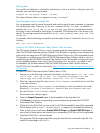
After generating the TLViz-formatted files from evaperf all output, you can build the Microsoft
Access database EVADATA.MDB:
1. Click Browse and select the evaerf all command out file.
2. Select Build Access Database.
3. Open the EVADATA.MDB file to view the database tables.
HP TLViz has limited space to display names (30 characters maximum). Included with the
TLViz-formatted files are map files (PDISK-MAP.txt and VDISK-MAP.txt) that map the
virtual disk and physical disk names displayed in HP TLViz to the LUN and enclosure/bay
names displayed in the HP P6000 Performance Data Collector output.
After generating the TLViz-formatted files, you can build a Microsoft Access database, if applicable:
1. Click Browse and select the all command output file.
2. Click Build Access Database.
3. Open the EVADATA.MDB file to view the database tables.
HP TLViz has limited space for displaying names (30 character maximum). Included with the
TLViz-formatted files are map files (PDISK-MAP.txt and VDISK-MAP.txt) that map the virtual
disk and physical disk names that display in HP TLViz to the LUN and enclosure/bay names that
display in the HP P6000 Performance Data Collector output.
Commands
This section describes the commands you can use in the command line interface to gather
performance metrics. The general syntax for commands is:
evaperf <command> [modifiers]
You can specify the command modifiers in any order.
Table 6 (page 82) describes the available HP P6000 Performance Data Collector commands. The
commands are listed alphabetically.
Table 6 HP P6000 Performance Data Collector commands
DescriptionCommand
Displays a summary of the array status by running the following commands together:
ls, as, cs, vd, vdg,hc, ps, hps, pd, pdg, drg, and drt.
all
Displays array status.as
Displays controller status.cs
Configures HP P6000 Command View login parameters to be used for state data
collection.
cvconfig <server port
username>
Displays the disk group configuration for the arrays managed by that host.dginfo
Displays data replication groups for HSV300, HSV400, and HSV450. The drg data
is displayed only from firmware version 9xxxxxx and later.
drg
Displays data replication tunnel statistics.drt
Deletes the password for the specified array from the host's Windows registry. The
password is not deleted on the array.
dpw wwn
Manages friendly name hosts as follows:fnh
• Displays a list of known hosts running HP P6000 Command View.
• Adds a host to the friendly name host list.
82 Monitoring array performance using HP P6000 Performance Data Collector


















